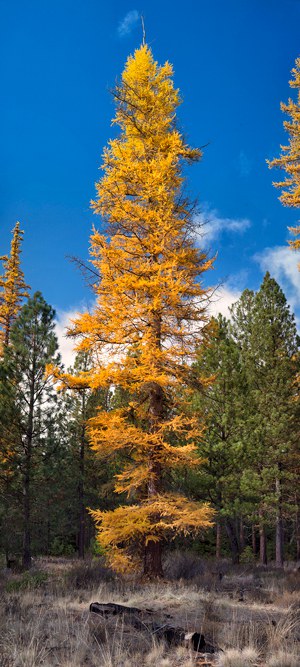October marks the peak of fall color season here in Central Oregon. It’s a great time to hit the trails or take a drive and take in all the changing leaves or needles. One colorful local tree that demands attention is the bright yellow Western Larch.

The Western larch is one of a handful of deciduous conifers in the conifer world. Deciduous trees are those that lose their leaves—or needles in this case—each fall. Most conifers—or cone-bearing trees—do not lose their needles and remain evergreen year round (hence the common name evergreen). Here in Central Oregon, our larch trees usually begin to change color in mid-October. First the needles will begin to show a hint of yellow, and then they’ll transition into a brilliant yellow that will fall to the ground and carpet the forest floor. Forests with lots of larch trees are particular spectacular in the fall as their golden needles offer a strong contrast to the sea of green ponderosa pine and Douglas fir.
In the natural world, Western larch is one of the first species to move in after a disturbance like a fire. It’s thick bark, deep roots, lack of lower limbs, and needles with high moisture content help it survive the regular low-intensity fires that occur in our region. Once Western larch move in, they help pave the way for more shade loving species that grow under them. A wide variety of wildlife use the resources the Western larch offers. Rodents and squirrels eat its seeds, birds look for insects and nest in its branches, deer and elk will browse on its needles, and bears eat its sweet sap in spring. Flying squirrels, woodpeckers, owls and other species will also nest in holes in the tree, and raptors will nest in the larch when it becomes a snag—a dead standing tree—later in life.
People also love and take advantage of the resources larch trees offer. Western larch is a valuable wood for construction and heating since it has the densest wood of all our conifers. Native Americans use the tree for medicinal treatments and make syrup from its sap and gum from its harder pitch. Western larch is also used in the production of turpentine and baking powder. But me, I love Western larch for its amazing color transformations and its soft, soft needles. What other tree can shower you in yellow in the fall, and then stun you with day-glo spring green all in the same year? And did I mention you can pet them? No joke, soft needles are a rarity in our conifer-dominated forests. Give it a try!
Looking for Larch?
Visit the Deschutes Land Trust’s Metolius Preserve near Camp Sherman. The Preserve, and area in general, are awash with the golden displays of Western larch from mid-October-early November. Shevlin Park in Bend is another easy destination to pet the larch trees. Finally, the Round Mountain South or Upper Lookout Mountain trailheads in the Ochoco National Forest offer great hiking trails with larch viewing opportunities. Don't forget that fall is also hunting season. Wear bright colors, avoid hiking at dawn and dusk, and be sure to leash Fido.
This story first appeared in the The Bulletin.
Learn more:
- Join a free, fall color walk or hike!
- Fall colors and where to find them
- Top Places for fall color in Central Oregon
Sources:
- Northwest Conifer Connections
- USFS: Larix occidentalis
- Plants of the Rocky Mountains by Kershaw, MacKinnon, and Pojar
- Rocky Mountain Natural History by Daniel Mathews


